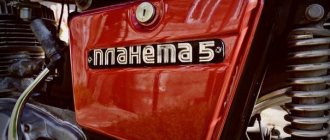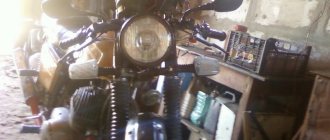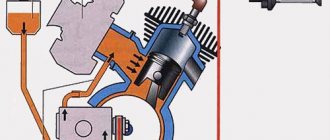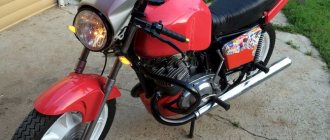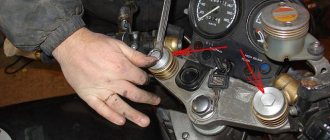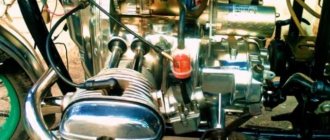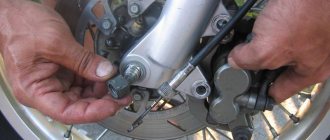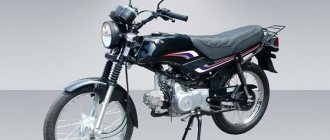The IZH Planet 5 motorcycle, created in 1987 by the Izhevsk plant, is still popular among motorcyclists. This is a very high-quality and reliable bike, characterized by durability, simplicity and affordability. Disassembling the IZH Planet 5 engine is quite simple even for amateurs. The design of the motorcycle itself does not contain complex elements.
Planet 5 is unpretentious to weather conditions. If you want to start the engine in a cold winter, it will surprise you, even if it is -30 degrees outside the window. Moreover, the motorcycle was designed to ride on various types of roads, which makes it very passable and an excellent assistant in agricultural work.
Like its counterpart, Jupiter 5, IZH Planet 5, whose engine performance is not much inferior to its “brother,” has a strict classic style. However, it has a number of advantages over Jupiter, the main of which are:
- single cylinder engine;
- disassembly and repair of the gearbox without removing the engine;
- presence of one muffler.
However, there is also a big disadvantage . The Planet's crankshaft is much more massive, so it operates at lower speeds, which makes it less powerful. Although the design of the IZH Planet 5 engine is practically no different from the Jupiter one. True, breakdowns occur no less frequently, so if you switched from one motorcycle to another, there should not be any special problems with operation and maintenance.
Intake, compression of a two-stroke motorcycle engine IZH
We start moving to TDC and block the purge channel on the left with the upper part of the piston. This creates a vacuum in the crankcase.
While the exhaust window of the cylinder is still open, exhaust and purging continue; after closing, compression of the combustible mixture begins.
The upward movement does not stop, and the edge of the skirt opens the crankcase inlet port. Through which the fuel mixture is sucked from the carburetor. Intake occurs.
Back to contents — ↑
Engine for the fifth model.
The Izh Planet 5 engine contains the following main characteristics and indicators:
- execution type – two-stroke with one cylinder;
- working volume – 345 cubic meters. cm;
- piston diameter – 72 mm;
- power – 22.0 l. With. at 4800 crankshaft rpm;
- battery voltage – 12 volts;
- cooling option – air;
- ignition type – contactless;
- the ratio of the mixture of oil and gasoline (A 76) is 1/30.
Such engine characteristics gave it a very important feature, which was to provide high traction performance at low speeds, which is important in rural road conditions.
Five random articles about motorcycles:
Three tips for Java 634 owners
On Java 634-01, 634-08 motorcycles, the tube through which electrolyte vapors are discharged from the battery ends at the rear wheel.
While driving, especially in summer, electrolyte gets onto the wheel, muffler, and other parts and damages their coating. Photo 1. Installing a bottle to collect electrolyte. I got rid of this trouble by shortening the tube and lowering it into a bottle with a stopper, which I installed in the right tool box, as shown in photo 1. To prevent the bottle from breaking, I made a frame for it from foam. The electrolyte accumulated in the bubble can be used by adding it to the battery. * * * Removing the piston from the connecting rod, which has a needle bearing in the upper head, is a simple matter (you just need to make sure that the needles do not get into the crankcase). But without the special devices described in the February 1978 issue of “Behind the Wheel.” it is difficult to install. If you have to do this on the road, you can use a simple bushing with an internal diameter of 16 mm, a length of 21 mm, which... Read more >>
Chezet 350 model 472.3
Return of Ceset (CZ 472 3) The CZ brand is well known in our country for the motocross motorcycles supplied to sports clubs, and, of course, for those machines on which the country's leading motorcyclists won prizes at world championships.
However, old motorcyclists also remember the road CZ classes 175 and 250 cm3, which arrived in the USSR in a small number fifteen years ago. Last fall, deliveries of road motorcycles of this famous one resumed, 1976, No. 12), and the editors had the opportunity to test the new model CZ-472 class 350 cm3. The engine of the new ChZ is almost no different from the well-known Java-634 engine; the only difference is a slight change in the rear mounting to the frame (in the ChZ it is narrower), the presence of a semi-automatic clutch release mechanism and a neutral indicator in the gearbox. And although the winter that came soon interrupted the test, we managed to get to know the ChZ-472 in sufficient detail. The general impression is that this is a pretty good road motorcycle... Read more >>
Protection of spark plugs on an IZH motorcycle
Spark plug protection When riding a motorcycle on a wet road at high speed, water from the front wheel gets under the cap of the high voltage wire, and then the spark on the spark plug disappears - the engine stops.
Spark plug protection on an IZh motorcycle: 1 - high voltage wire cap; 2 - spark plug insulator: 3 - rubber washer 1 mm thick. One day in the rain, because of this, I lost a lot of time trying different options for protecting the candles. The simplest and absolutely reliable method turned out to be, the essence of which is clear from the figure. The rubber washer 3. fits tightly onto the spark plug insulator and fits inside the cap, does not allow water to pass through, even when you wash the motorcycle from the Hose.A. DAGAEV60311, G. Gorky, st. Belinsky, 35, Iv. 1 1974N07P38 Read more >>
If the thread for the spark plug in the cylinder head of IZH-Jupiter-3, 4 or 5 has broken
Installing a liner in the head If the IZH-Jupiter-3, “4” or “5” motorcycles have a broken thread for a spark plug in the cylinder head, install a liner, as is customary, (see figure), but only of a larger length so that you can use spark plugs with a long (19 mm) threaded part - A17DV, A17D1 and others intended for Muscovites and Lada cars.
We make the fitting from brass and screw it in with BF-2 glue. Installing the fitting in the head. Many years of operation of engines with these spark plugs has shown that they work no worse than with standard ones. Moscow, E. CLOGS 1988N06P33 Read more >>
Reasons for repair.
Complete disassembly of the Izh Planet 5 engine during repair work is carried out if damage or breakdown of the following elements occurs:
- crankshaft;
- bearings;
- piston;
- connecting rod
Failure of these parts can occur due to engine jamming, general severe wear, which is accompanied by increased noise during operation, as well as various knocking noises in the crankcase. In addition, repair of the Izh Planet engine with its complete disassembly is carried out when the crankshaft seals are worn out.
The presence of such a breakdown is indicated by the following points: difficult starting of the internal combustion engine, loss of power, increased smoke.
At the initial stage of production of power units, the reed valve on the Izh Planet 5 had certain technological shortcomings associated with low strength. Therefore, it quickly collapsed, its elements fell inside the cylinder, which required further disassembly and, in most cases, replacement of the Izh Planet 5 piston. After a certain time, the manufacturer eliminated this defect.
If, when operating the engine, all routine and technical maintenance procedures established by the manufacturer were observed, and appropriate technological materials and fluids were used, then it was operated for a long time, while maintaining its technical parameters.
IZH Planet 5 engine diagram
| 1 - spark plug; | 2 - cylinder head; |
| 3 - cylinder: | 4 - piston; |
| 5 - piston ring; | 6 - piston pin: |
| 7 - crankcase; | 8 – channel for lubrication of the main bearing; |
| 9 — roller bearing; | 10 — left oil seal; P - left cover; |
| 12 — motor chain; | 13 - ball bearing; |
| 14 — crankshaft sprocket: | 15 — outer drum of the clutch; 16 — clutch disc; |
| 17 - inner drum: | 18 — pressure disk; |
| 19 — spring; | 20 - shaped nut; |
| 21 - pusher; | |
| 22 — ball bearing; | 23 — trigger gear; |
| 24 — gear shift lever; | 25 — trigger lever: |
| 26 — trigger shaft; | 27 — gear shift shaft; |
| 28 — trigger sector; | 29 - spring: |
| 30, 31, 32. 39, 40, 42 — gearbox gears; | 33 — gear shift fork; |
| 34 — emphasis; | 35 — gear shift shaft; |
| 36 — gearbox cover; | 37 — installation sleeve; |
| 38 — right cover; | |
| 41 - intermediate shaft; | 43 - ball bearing; |
| 44 - roller bearing: | 45 - secondary shaft; |
| 46 - input shaft: | 47 — clutch adjusting screw: |
| 48 - worm ball; | 49 — clutch worm; |
| 50 — cap of the secondary shaft nut; | 51 - oil seal; |
| 52 — asterisk; | 53 - generator; |
| 54 — right oil seal; | 55 — roller bearing; |
| 56 - gasket; | 57 - crankshaft; |
| 58 - bypass channel; | 59 — exhaust window; |
| 60 - decompressor |
With a power of 22 horsepower, the engine capacity of the IZH Planet 5 is 346 cc . This is a very good indicator for such a small volume. For normal use, a speed of 120 km/h is sufficient. True, the dynamics of the Planet are slightly worse than Jupiter, and unnecessary vibrations are disturbing on the road. However, not everyone is satisfied with such indicators, so many are thinking about how to increase the engine power of the IZH Planet 5.
In general, the bike has standard electrical equipment, an air cooling system, a multi-disc clutch and a 4-speed gearbox. The engine itself operates in two strokes. An oil-gasoline mixture is used for refueling. As you can see, the performance of IZH Planet 5, whose engine characteristics are not much different from Jupiter, can allow it to act as a “workhorse”.
Motorcycle engine IZH PS
The production of motorcycles with single-cylinder two-stroke engines with a displacement of 300-350 cm3 has a nearly forty-year tradition in Izhevsk.
If we trace the pedigree of road models over the past four decades, we will see that the latest design, being to a certain extent a bearer of traditions, embodies many developments first tested on sports cars of the IZH brand. The engine of the IZH-Planeta-Sport motorcycle is short-stroke (cylinder diameter - 76 mm, piston stroke - 75 mm, working volume - 340 cm3), with three-channel purging and a gear motor transmission - retains a number of important features common to experimental IZH engines , intended for cross-country and all-around. In 1961-1967, engines for sports cars IZH-349, IZH-65M, IZH-10M were created in Izhevsk, which, with a working volume of 340 cm3, developed a power of 25-34 hp. With. Some of their samples had the same piston diameter and stroke, type of purge, head and cylinder mounting, type of motor transmission as the IZH-Planet-Sport model.
1 — gear shift pedal; 2 — clutch; 3 — drive gear of the motor transmission; 4 - oil pump; 5 - plug with oil dipstick; b — crankshaft cheek; 7 — connecting rod; 8 — speedometer drive shaft; 9 — purge channels; 10 — exhaust pipe; 11 — opening for one of the four long cylinder mounting studs; 12 — piston rings; 13 - candle; 14 — piston pin; 15 — upper head of the connecting rod with a needle bearing; 16 - piston; 17 — decompressor; 18 — one of two short head mounting studs; 19 — cylinder liner; 20 — oil supply hose; 21 — throttle control cable; 22 — drainage hose; 23 — carburetor with a central location of the float chamber; 24 - float chamber; 25 — gearbox gears; 26 — clutch release lever; 27 — clutch release rod; 28 — main gear drive sprocket; 29 — sector of the gear shift mechanism; 30, 32 — gear shift forks; 31 - worm control shaft for forks; 33 — gear shift shaft; 34 - driven gear of the motor transmission.
Now many of these design solutions have been transferred from experimental sports models to production ones, which once again demonstrates the progressive influence of sports on the development of technology.
Let's look at the design of the IZH-Planet-Sport engine, a new car that has already begun to reach motorcyclists.
It, like all modern motorcycle engines, is assembled in one block with a gearbox. The engine crank chamber is located in the front part of the common crankcase, which has a longitudinal vertical plane of the connector, and the gearbox is located in the rear part. Noteworthy are the unusually small dimensions of the crankcase, achieved thanks to the dense arrangement of parts and side covers that are as close to them as possible.
The cylinder, like all Izhevsk motorcycles, has an aluminum jacket and a sleeve 19 made of special cast iron. For the first time, such cylinders appeared on a small batch of cross-country IZH-350S in 1948, and since 1956 they have already found application on the serial road model - IZH-56. Their advantages over all-cast iron cylinders - lighter weight and better cooling (aluminum has greater thermal conductivity), as well as well-mastered technology - predetermined the choice of the designers.
The cylinder head is cast from aluminum alloy and provides the necessary cooling.
The cylinder together with the head is attached to the crankcase with four studs, and the head, in addition, is pulled to the cylinder with two more nuts, into the jacket of which two short studs are screwed.
“IZH-Planeta-Sport” is the first production model of the Izhevsk plant with a three-channel loop blower. It is interesting to recall that the IZH-7 engines of 1934 had a single-channel transverse scavenging with a deflector on the piston, then, starting with IZH-8, the plant switched to a two-channel loop scavenging, and, finally, the next logical step was the transition to a three-channel scavenging (left and rear channels 9 are visible in the figure). It is very often used on highly accelerated racing engines, as it increases the filling of the cylinder and improves the cooling of the piston bottom, relieving it from overheating and burnout, increases the wear resistance of parts of the cylinder-piston group, and reduces fuel consumption.
To reduce friction losses, needle bearings are installed in the upper 15th head of the connecting rod, replacing the traditional bronze bushing. They are able to withstand high speeds, are more durable and provide an increase in power.
The crankshaft of a non-separable design is mounted on three bearings: two 2505 roller bearings and a 304 ball bearing, located at the end of the left axle. This bearing keeps the shaft from axial displacement. To impart force from the shaft to the gearbox, two helical gears 3 and 34 are used. They are more reliable and durable than the conventional chain drive.
One of the most interesting new products, first used in the domestic motorcycle industry, is a separate engine lubrication system. Typically, two-stroke engines are lubricated with oil, which is mixed with fuel in a ratio of 1: 25. Thus, the amount of it entering the engine depends only on the amount of gasoline supplied. For normal lubrication of rubbing parts, different engine operating modes require different oil supplies: the lower the speed and load, the less oil is needed, and vice versa.
It is these conditions that are ensured by the system used at Planet-Sport. Oil is poured into a separate tank and, through pump 4, is supplied through hose 20 into the intake system. The pump is driven directly from the crankshaft, and its metering device is controlled by a cable interlocked with the carburetor control cable. As the engine speed or load increases (at this time the driver “gives the gas”, that is, raises the throttle valve), the pump performance increases. To monitor the flow of oil, a warning lamp on the headlight housing is used, connected to a discharge valve sensor, which is installed on the crankcase between the cylinder and the carburetor.
The new system not only provides optimal lubrication conditions, but also saves oil (1.2-2.5 percent is consumed in relation to gasoline instead of 4 percent in a conventional system), and this has a positive effect on mixture formation and reduces the amount of soot and toxicity of exhaust gases .
The engine is equipped with a carburetor 23 with a central float chamber 24 and a diffuser with a diameter of 32 mm. Unlike common side-chamber carburetors, it is more compact and keeps the fuel level, and therefore the composition of the mixture, constant regardless of the longitudinal or transverse inclination of the car.
If we look at history, we can find out that carburetors with a central float chamber (LKZ-22) were used on pre-war IZH motorcycles. Then they gave way to other designs, and now the central chamber carburetor has again entered the scene.
The Planet-Sport model is the first of the Izhevsk motorcycles with an air filter with a paper element. Pre-war IZh vehicles and the post-war IZH-350 had relatively ineffective mesh air cleaners. The experience of participating in cross-country races brought a lot of useful information in the field of improving air purification. An inertial filter appeared on the IZH-49 in 1951, later the IZH-56 was equipped with a contact oil filter, and now, based on the practice of operating cars in cross-country races and multi-day races, the designers of IZH-Planet-Sport chose a paper filter element.
They also faced the question of how to reduce the impact of vibration inherent in a single-cylinder engine on the motorcycle and driver. The following solution was found here: the power unit, muffler, steering wheel, and gas tank are connected to the frame via rubber elements.
This is, in general terms, the design of the engine of the new Izhevsk motorcycle.
Technical specifications
